2007 CHEVROLET SUBURBAN service
[x] Cancel search: servicePage 128 of 634
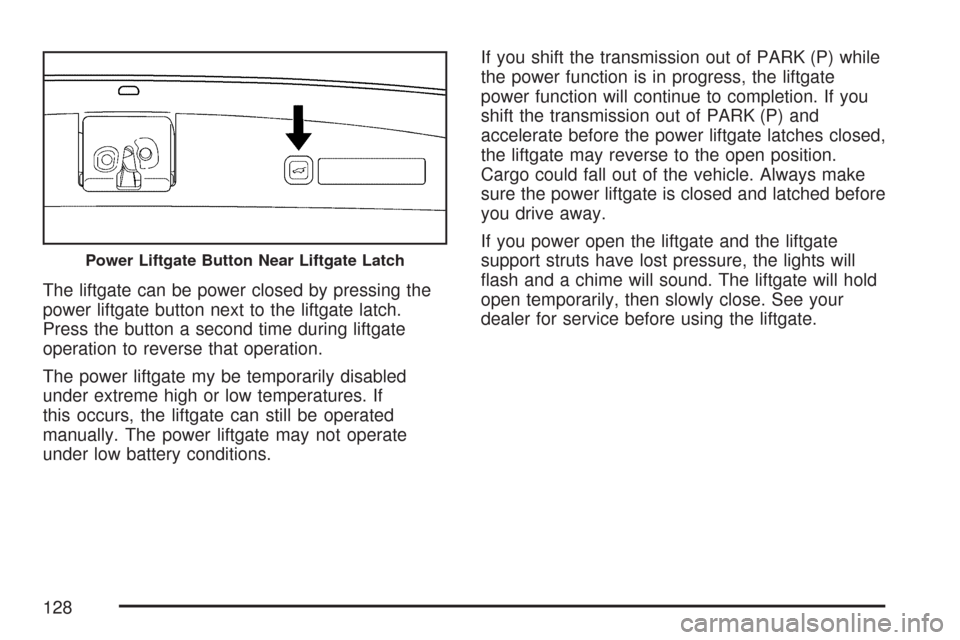
The liftgate can be power closed by pressing the
power liftgate button next to the liftgate latch.
Press the button a second time during liftgate
operation to reverse that operation.
The power liftgate my be temporarily disabled
under extreme high or low temperatures. If
this occurs, the liftgate can still be operated
manually. The power liftgate may not operate
under low battery conditions.If you shift the transmission out of PARK (P) while
the power function is in progress, the liftgate
power function will continue to completion. If you
shift the transmission out of PARK (P) and
accelerate before the power liftgate latches closed,
the liftgate may reverse to the open position.
Cargo could fall out of the vehicle. Always make
sure the power liftgate is closed and latched before
you drive away.
If you power open the liftgate and the liftgate
support struts have lost pressure, the lights will
�ash and a chime will sound. The liftgate will hold
open temporarily, then slowly close. See your
dealer for service before using the liftgate.
Power Liftgate Button Near Liftgate Latch
128
Page 130 of 634

It is not recommended that you drive with the
liftgate open, however, if you must drive with the
liftgate open, the power liftgate should be switched
to manual liftgate operation — the overhead
console switch set to the “Disable” position.
Both the liftglass and liftgate have an electric latch.
If the battery is disconnected or has low voltage,
the liftglass and liftgate will not open. The
liftglass and liftgate will resume operation when
the battery is reconnected and charged.
If the battery is properly connected and has
adequate voltage, and the liftgate or liftglass still
will not function, your vehicle should be taken to a
dealership for service.
{CAUTION:
It can be dangerous to drive with the
liftglass or liftgate open because carbon
monoxide (CO) gas can come into your
vehicle. You cannot see or smell CO. It can
cause unconsciousness and even death.
CAUTION: (Continued)
CAUTION: (Continued)
If you must drive with the liftglass or
liftgate open, or if electrical wiring or
other cable connections must pass
through the seal between the body and
the liftglass or liftgate:
Make sure all other windows are shut.
Turn the fan on your heating or
cooling system to its highest speed
with the recirculation mode off. That
will force outside air into your vehicle.
SeeClimate Control System on
page 227orDual Automatic Climate
Control System on page 231.
If you have air outlets on or under
the instrument panel, open them all
the way.
If your vehicle has a power liftgate,
disable the power liftgate function.
SeeEngine Exhaust on page 160.
130
Page 136 of 634
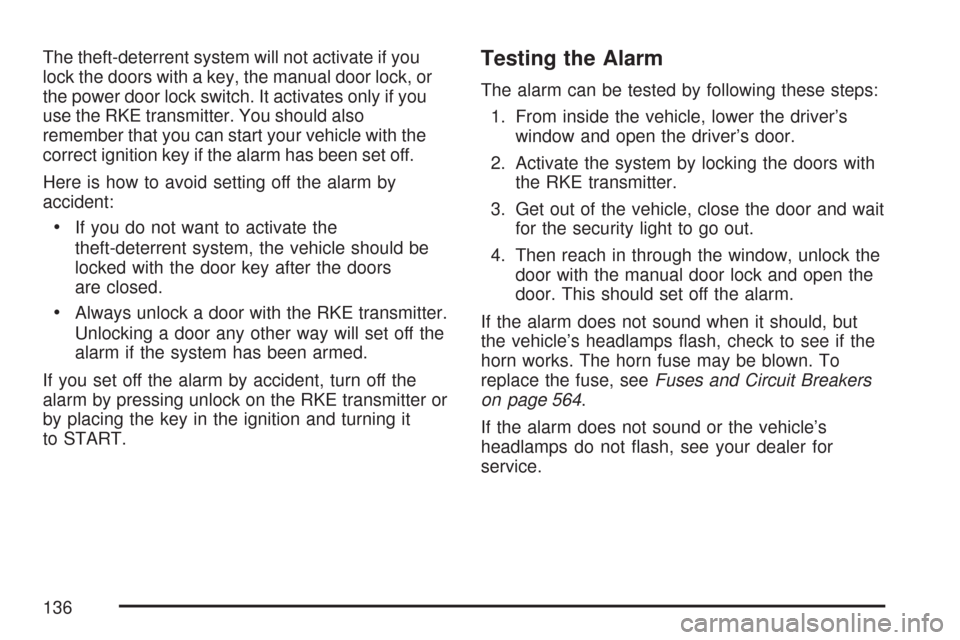
The theft-deterrent system will not activate if you
lock the doors with a key, the manual door lock, or
the power door lock switch. It activates only if you
use the RKE transmitter. You should also
remember that you can start your vehicle with the
correct ignition key if the alarm has been set off.
Here is how to avoid setting off the alarm by
accident:
If you do not want to activate the
theft-deterrent system, the vehicle should be
locked with the door key after the doors
are closed.
Always unlock a door with the RKE transmitter.
Unlocking a door any other way will set off the
alarm if the system has been armed.
If you set off the alarm by accident, turn off the
alarm by pressing unlock on the RKE transmitter or
by placing the key in the ignition and turning it
to START.
Testing the Alarm
The alarm can be tested by following these steps:
1. From inside the vehicle, lower the driver’s
window and open the driver’s door.
2. Activate the system by locking the doors with
the RKE transmitter.
3. Get out of the vehicle, close the door and wait
for the security light to go out.
4. Then reach in through the window, unlock the
door with the manual door lock and open the
door. This should set off the alarm.
If the alarm does not sound when it should, but
the vehicle’s headlamps �ash, check to see if the
horn works. The horn fuse may be blown. To
replace the fuse, seeFuses and Circuit Breakers
on page 564.
If the alarm does not sound or the vehicle’s
headlamps do not �ash, see your dealer for
service.
136
Page 137 of 634
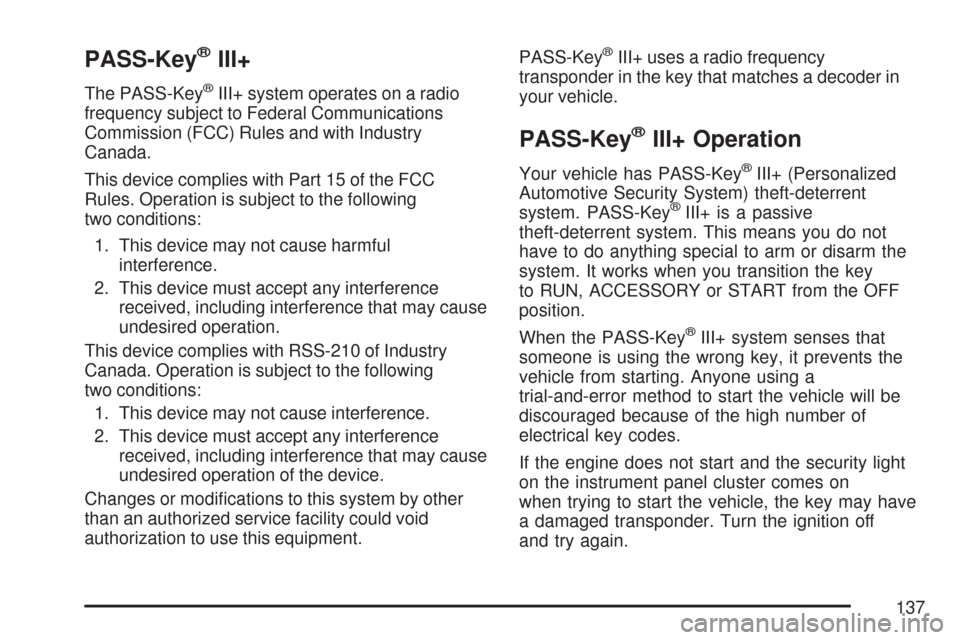
PASS-Key®III+
The PASS-Key®III+ system operates on a radio
frequency subject to Federal Communications
Commission (FCC) Rules and with Industry
Canada.
This device complies with Part 15 of the FCC
Rules. Operation is subject to the following
two conditions:
1. This device may not cause harmful
interference.
2. This device must accept any interference
received, including interference that may cause
undesired operation.
This device complies with RSS-210 of Industry
Canada. Operation is subject to the following
two conditions:
1. This device may not cause interference.
2. This device must accept any interference
received, including interference that may cause
undesired operation of the device.
Changes or modi�cations to this system by other
than an authorized service facility could void
authorization to use this equipment.PASS-Key
®III+ uses a radio frequency
transponder in the key that matches a decoder in
your vehicle.
PASS-Key®III+ Operation
Your vehicle has PASS-Key®III+ (Personalized
Automotive Security System) theft-deterrent
system. PASS-Key
®III+ is a passive
theft-deterrent system. This means you do not
have to do anything special to arm or disarm the
system. It works when you transition the key
to RUN, ACCESSORY or START from the OFF
position.
When the PASS-Key
®III+ system senses that
someone is using the wrong key, it prevents the
vehicle from starting. Anyone using a
trial-and-error method to start the vehicle will be
discouraged because of the high number of
electrical key codes.
If the engine does not start and the security light
on the instrument panel cluster comes on
when trying to start the vehicle, the key may have
a damaged transponder. Turn the ignition off
and try again.
137
Page 138 of 634
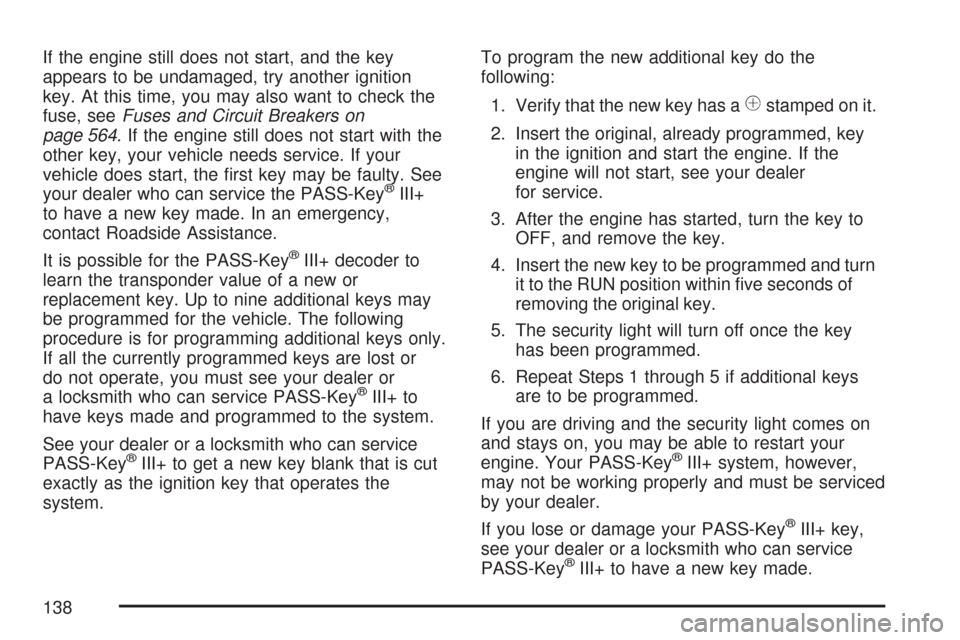
If the engine still does not start, and the key
appears to be undamaged, try another ignition
key. At this time, you may also want to check the
fuse, seeFuses and Circuit Breakers on
page 564. If the engine still does not start with the
other key, your vehicle needs service. If your
vehicle does start, the �rst key may be faulty. See
your dealer who can service the PASS-Key
®III+
to have a new key made. In an emergency,
contact Roadside Assistance.
It is possible for the PASS-Key
®III+ decoder to
learn the transponder value of a new or
replacement key. Up to nine additional keys may
be programmed for the vehicle. The following
procedure is for programming additional keys only.
If all the currently programmed keys are lost or
do not operate, you must see your dealer or
a locksmith who can service PASS-Key
®III+ to
have keys made and programmed to the system.
See your dealer or a locksmith who can service
PASS-Key
®III+ to get a new key blank that is cut
exactly as the ignition key that operates the
system.To program the new additional key do the
following:
1. Verify that the new key has a
1stamped on it.
2. Insert the original, already programmed, key
in the ignition and start the engine. If the
engine will not start, see your dealer
for service.
3. After the engine has started, turn the key to
OFF, and remove the key.
4. Insert the new key to be programmed and turn
it to the RUN position within �ve seconds of
removing the original key.
5. The security light will turn off once the key
has been programmed.
6. Repeat Steps 1 through 5 if additional keys
are to be programmed.
If you are driving and the security light comes on
and stays on, you may be able to restart your
engine. Your PASS-Key
®III+ system, however,
may not be working properly and must be serviced
by your dealer.
If you lose or damage your PASS-Key
®III+ key,
see your dealer or a locksmith who can service
PASS-Key
®III+ to have a new key made.
138
Page 140 of 634

Ignition Positions
Use the key to turn the ignition switch to four
different positions.
A (LOCK):This position locks the ignition and
transmission. It is a theft-deterrent feature. You will
only be able to remove the key when the ignition is
turned to LOCK.Notice:Using a tool to force the key from the
ignition switch could cause damage or break
the key. Use the correct key and turn the key
only with your hand. Make sure the key is all the
way in. If it is, turn the steering wheel left and
right while you turn the key hard. If none of this
works, then your vehicle needs service.
B (ACCESSORY):This position lets you use
things like the radio and the windshield wipers when
the engine is off.
Lengthy operation of features such as the radio in
the ACCESSORY ignition position and the RUN
position may drain the battery and prevent your
vehicle from starting. Do not operate your vehicle in
the ACCESSORY ignition position for a long period
of time.
C (RUN):This is the position for driving. It is the
position the switch returns to after the engine starts,
and you release the key.
The battery could be drained if you leave the key in
the ACCESSORY or RUN position with the engine
off. You may not be able to start your vehicle if the
battery is allowed to drain for an extended period
of time.
D (START):This position starts the engine.
140
Page 151 of 634

You can choose among �ve driving settings:
Indicator lights in the switches show you which
setting you are in. The indicator lights will come on
brie�y when you turn on the ignition and the last
chosen setting will stay on. If the lights do not
come on, you should take your vehicle in for
service. An indicator light will �ash while shifting.
Fast �ashing means the conditions were not
met to make the desired shift, typically the vehicle
was going too fast, the automatic transmission
was not in neutral, or the clutch pedal was not fully
pressed. Slow �ashing means the shift is in
progress. It will stay on when the shift is
completed. If for some reason the transfer case
cannot make a requested shift, it will return to the
last chosen setting.
2
m(Two-Wheel Drive High):This setting is
used for driving in most street and highway
situations. Your front axle is not engaged in
two-wheel drive. This setting also provides the best
fuel economy.AUTO (Automatic Four-Wheel Drive):This
setting is ideal for use when road surface traction
conditions are variable. When driving your
vehicle in AUTO, the front axle is engaged, but
the vehicle’s power is primarily sent to the
rear wheels. When the vehicle’s software
determines a need for more traction, the system
will transfer more power to the front wheels.
Driving in this mode results in slightly lower fuel
economy than Two-Wheel Drive High.
4
m(Four-Wheel Drive High):Use the
four-wheel high position when you need extra
traction, such as on snowy or icy roads or in most
off-road situations. This setting also engages
your front axle to help drive your vehicle. This is
the best setting to use when plowing snow.
151
Page 152 of 634
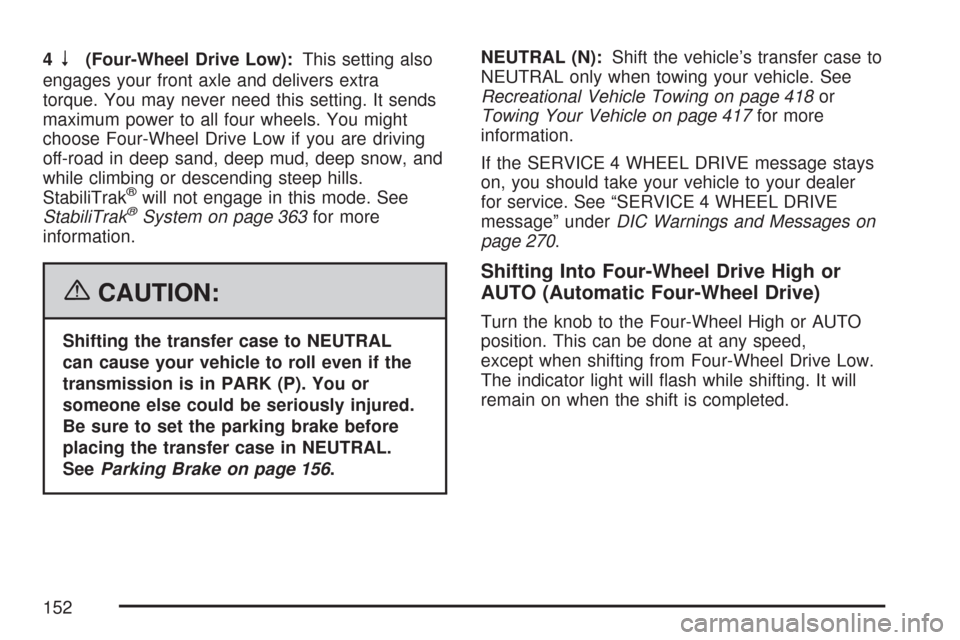
4n(Four-Wheel Drive Low):This setting also
engages your front axle and delivers extra
torque. You may never need this setting. It sends
maximum power to all four wheels. You might
choose Four-Wheel Drive Low if you are driving
off-road in deep sand, deep mud, deep snow, and
while climbing or descending steep hills.
StabiliTrak
®will not engage in this mode. See
StabiliTrak®System on page 363for more
information.
{CAUTION:
Shifting the transfer case to NEUTRAL
can cause your vehicle to roll even if the
transmission is in PARK (P). You or
someone else could be seriously injured.
Be sure to set the parking brake before
placing the transfer case in NEUTRAL.
SeeParking Brake on page 156.NEUTRAL (N):Shift the vehicle’s transfer case to
NEUTRAL only when towing your vehicle. See
Recreational Vehicle Towing on page 418or
Towing Your Vehicle on page 417for more
information.
If the SERVICE 4 WHEEL DRIVE message stays
on, you should take your vehicle to your dealer
for service. See “SERVICE 4 WHEEL DRIVE
message” underDIC Warnings and Messages on
page 270.
Shifting Into Four-Wheel Drive High or
AUTO (Automatic Four-Wheel Drive)
Turn the knob to the Four-Wheel High or AUTO
position. This can be done at any speed,
except when shifting from Four-Wheel Drive Low.
The indicator light will �ash while shifting. It will
remain on when the shift is completed.
152